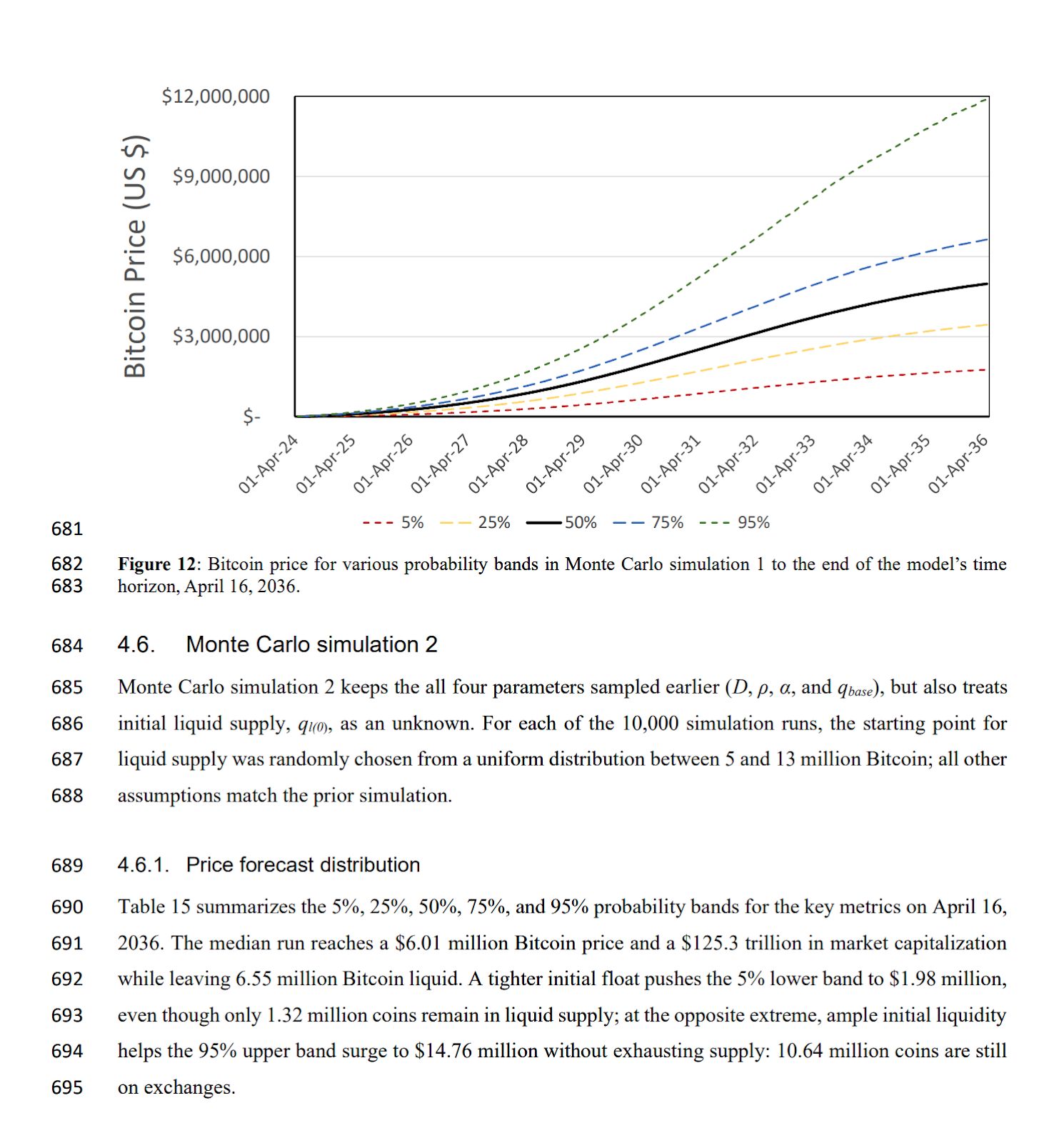Bitcoin Price Could Exceed $4.81M by 2036, New Prediction Shows
A new probability model projects Bitcoin could exceed $4.81M by 2036, with supply constraints and institutional accumulation driving valuations. Analysts see post-2026 imbalances significantly boosting median and extreme price scenarios.
A new study from Satoshi Action Education projects a 75% probability that Bitcoin will exceed $4.81 million by April 2036.
The research, led by economist Murray A. Rudd, uses an updated probability model to examine how supply constraints and institutional demand could influence long-term valuations.
Supply Shock Scenarios and Bitcoin Price
The updated results show a 75% exceedance price of $4.81 million for April 2036. The 25% exceedance band reaches $10.22 million, while the 95% upper bound ranges from $11.89 million to $14.76 million, depending on the simulation parameters. In the most extreme one percent of simulations, peaks approach $50 million. Median projections are about $6.55 million to $6.96 million for the same date.
Bitcoin’s 21 million supply cap and an estimated liquid float of nearly 3 million BTC anchor the supply side. Long-term storage, corporate collateralization, DeFi activity, and Layer 2 networks are expected to further reduce the tradable supply. Baseline and median scenarios keep liquid supply between 6.55 million and 6.96 million BTC by April 2036, moderating extreme projections.

Stress-path simulations illustrate how persistent exchange withdrawals could accelerate scarcity. If the circulating liquid supply drops below 2 million BTC with low contraction sensitivity, the model shows prices could escalate rapidly. In the worst one percent of depletion paths, liquid supply falls below 2 million BTC by Jan. 19, 2026, and below 1 million BTC by Dec. 7, 2027.
The updated model projects significantly higher prices than January’s report, which used more conservative adoption and liquidity assumptions. The researchers attribute this to sharper post-2026 supply–demand imbalances and structural constraints that limit available supply. The model incorporates institutional accumulation patterns, slowing purchases during rallies and increasing them during stable conditions.
The study notes that investor awareness of liquidity risk will be essential as adoption grows. It emphasizes that there is a narrow margin between sustainable scarcity and destabilizing depletion, with the latter potentially causing outsized volatility.
Portfolio Strategy Implications
The findings have implications for portfolio strategy and policy. For long-term allocators, the steep right tail of the price distribution supports strategies that account for asymmetric upside while respecting liquidity constraints. Policymakers may need to address custody concentration and cross-border capital flows as corporate treasuries, sovereign reserves, and tokenization initiatives increase pressure on circulating supply.
Combining macro-level adoption curves with micro-level liquidity events, the Monte Carlo framework and Epstein–Zin utility specification offer a more comprehensive view than simpler projection models. Multiple constraint factors are integrated to simulate how Bitcoin’s price could evolve under varying market and policy conditions.
As reported by BeInCrypto, Bitcoin entered uncharted territory on Thursday, breaking above $124,000 to set a new all-time high. The price is up nearly 8% over the past week. Analysts point to a confluence of bullish on-chain signals suggesting that the rally may still have room to run.
Disclaimer: The content of this article solely reflects the author's opinion and does not represent the platform in any capacity. This article is not intended to serve as a reference for making investment decisions.
You may also like
2025 TGE Survival Ranking: Who Will Rise to the Top and Who Will Fall? Complete Grading of 30+ New Tokens, AVICI Dominates S+
The article analyzes the TGE performance of multiple blockchain projects, evaluating project performance using three dimensions: current price versus all-time high, time span, and liquidity-to-market cap ratio. Projects are then categorized into five grades: S, A, B, C, and D. Summary generated by Mars AI This summary was generated by the Mars AI model, and the accuracy and completeness of its content are still being iteratively updated.

Mars Finance | "Machi" increases long positions, profits exceed 10 million dollars, whale shorts 1,000 BTC
Russian households have invested 3.7 billion rubles in cryptocurrency derivatives, mainly dominated by a few large players. INTERPOL has listed cryptocurrency fraud as a global threat. Malicious Chrome extensions are stealing Solana funds. The UK has proposed new tax regulations for DeFi. Bitcoin surpasses $91,000. Summary generated by Mars AI. The accuracy and completeness of this summary are still being iteratively updated by the Mars AI model.

How much is ETH really worth? Hashed provides 10 different valuation methods in one go
After taking a weighted average, the fair price of ETH exceeds $4,700.

Dragonfly partner: Crypto has fallen into financial cynicism, and those valuing public blockchains with PE ratios have already lost
People tend to overestimate what can happen in two years, but underestimate what can happen in ten years.

